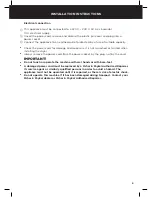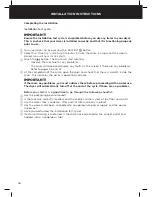
17
SORTING AND LOADING
Drying times
●
●
Drying very small loads is inefficient. Try to dry medium to large loads.
●
●
Heavier items (towels, flannelette sheets) will take longer to dry than light items
(synthetics and polyester cotton sheets and shirts).
●
●
Drying times can be reduced by spinning the wash load at the highest spin speed
suitable for the load type in your washing machine.
Drying bulky items
●
●
It is important that you check the care label of any item carefully, to ensure it is suitable
for tumble drying before placing it into the dryer.
●
●
Check bulky items during the cycle to ensure even drying, pause the dryer and
reposition the item if necessary.
●
●
Do not overload the dryer, ensure there is enough space for the item to tumble.
Lint
Some items are lint givers, while others are lint collectors. Always dry lint givers and
collectors separately.
LINT GIVERS
LINT COLLECTORS
Towels
Synthetics eg polar fleece
Flannelette sheets
Corduroy
Polyester cottons
Delicate or easily damaged items (eg woollen or silk garments, nylon stockings, fine
fabrics, delicate embroidered fabrics) should be dried separately, using the ‘Delicate’
cycle, or if you do not want them tumbled use the ‘Wool’ or ‘Rack Dry’ cycle. Sleeping
bags and other down items should be dried on the ‘Bulky’ cycle.
Drying rack
There are many items that would benefit from
being dried on a drying rack. For example items
such as sport shoes, soft toys, hats and woollen
items that may be damaged if they are tumbled.
A drying rack is installed in your dryer when it
leaves the factory. To remove it, tilt the top of
the rack towards you to detach the legs from
the slots in the lint filter, and gently remove from
the drum.
When you are using the drying rack you must
select the ‘Rack Dry’ or ‘Wool’ cycle.
Drying rack
Drying rack cycle
Содержание DH8060P
Страница 1: ...Heat pump clothes dryer DH8060P model NZ AU INSTALLATION INSTRUCTIONS USER GUIDE ...
Страница 2: ......
















































